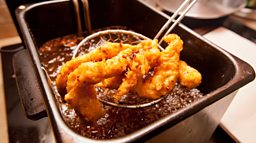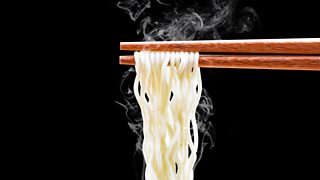The joys of deep fat frying
Deep-fried food is nothing new. The ancient Greeks staged comedies involving frying pans and the Romans fried fish in copious amounts of oil. In The Food Programme Rachel McCormack explores different cultures' approaches to deep-frying and asks: is deep-fried food friend or foe?
The days of deep-frying getting a bad rap may be behind us as the culinary delicacy has become trendy. It's even popping up unexpectedly in the most classy of restaurants, and internationally it has an important place in a balanced, healthy diet.
The frying pans of Ancient Greece
Professor of Greek culture at Exeter University, John Wilkins, explains how cooking popped up in all the comedies of Ancient Greece. Cuisine was a huge part of Greek culture, and people expected cooking to feature in the theatre productions they went to see.
“The most striking thing from the ancient world is a play of Aristophanes’, a comedy written in about 420 BC, with a chorus of men holding frying pans,” says John.
Fried red mullet in Ancient Rome
A Roman cookbook from the 4th century BC describes frying fish (like red mullet) in oil, as well as chunks of meat. Professor John Wilkins explains how the writer quite explicitly directs the reader to “use as much oil as is necessary” when cooking the fish. We know that Roman pans weren’t shallow, so, “it’s a sort of deep-frying” says John. Although he admits it’s not quite on par with our modern deep fat fryers: “No chip pans in the ancient world I think!”

The history of the British chippy
Why did fish and chips become so popular in the UK?
Professor Murray Pittock, a cultural historian at Glasgow University, thinks the answer lies in Italy. By 1918 there were about 4000 Italians in Scotland, with many starting up fish and chip businesses. 2019 will see the 38th Fish and Chip Festival in Lucca in Italy, supporting the theory that the dish was brought from Barga to Scotland in the late 19th century and that “ultimately it’s an Italian dish.”
Although “you can’t be absolutely sure where it comes from in the end,” says Murray, “there does seem to be – whether it’s Iberia or Italian – a Mediterranean fried fish tinge… to the native creation of fish and chips.”
Food writer Claudia Roden thinks “the Italians got it from the Jews”. During Hanukkah, the 8-day Jewish festival of light, it is traditional to eat fried food dishes like sufganiyot (jam-filled doughnuts) and latkes (potato fritters). In 1860, says the food writer, the first fish fryer putting fish and chips together was a London-based Jew from Russia called Joseph Malin. The Jewish tradition of frying fish met with the Irish potato shops of the East End, and voila, the British national dish was made.

Deep-frying around the globe
Spain
The Food Programme presenter Rachel McCormack explains how she learnt about deep-frying, not in her hometown of Glasgow, but in Spain. The Spanish deep-fry everything from croquetas to calamari, and have festivals with big vats for frying doughnuts or salt cod fritters. The president of the Royal Academy of Andalucían Gastronomy says the Spanish have olive oil in the blood: Andalucía has millions of olive trees and it’s an integral part of the diet and lifestyle.
Italy
In Italy, fritto misto is a popular dish. “The Romans deep fry everything” says food writer Claudia Roden, “tiny lamb chops, sweetbreads, liver, artichoke, courgettes, ricotta, apples, pears, pieces of bread, cheese, salt cod… it goes on and on.”
Rachel meets Luca, the chef at an Italian restaurant in Glasgow, who explains how in Turin a fritto misto often contains peaches, bananas, or apples. As in Spain, deep-frying is not considered unhealthy. It’s all about the balance, says Luca: “We would have it with a salad.”
Japan
Tempura is a Japanese dish that usually comprises seafood or vegetables that have been battered and deep-fried. Tempura’s roots are also likely to be in Europe: the dish was influenced by fritter-cooking techniques introduced by the Portuguese living in Nagasaki in the 16th century.
The science behind deep-frying
Anne Pawsey, physicist at Edinburgh University, explains the science behind deep-frying.
When you drop room-temperature food into hot oil, which is around 180 degrees Celsius, the surface water on the food immediately vaporises, producing the signature sizzling sound. The outside of the food, which is normally covered in starch, starts to create a film, and “this film is effectively waterproof and oil proof,” says Anne. “Any water that’s in the food can’t get out, and equally oil can’t really get in.” Inside that waterproof layer the food steams itself.
Greasy myths: which oils are actually good for you?

Busting the myth about which oils are best for you.

The health benefits of frying food
Remarkably, yes, says Anne: “There are certainly advantages to frying things, particularly in terms of preserving certain flavours and nutrients, because they’re water soluble. If you cook in fat they’re not going to leak out particularly fast and so you actually preserve them within the food.”
When you drop room-temperature food into hot oil, which is around 180 degrees Celsius, the surface water on the food immediately vaporises, producing the signature sizzling sound.
Dr Rangan Chatterjee, 主播大秀 1’s Doctor in the House, says it’s all to do with the quality of the oil. Many chip shops use vegetable oil, which is reheated again and again. “If it is heated to high heats it can become oxidised,” says Rangan, “which is a little bit like rusting on your car – we don’t really want that happening to the oil that we’re putting inside our bodies.” This damaged oil “contributes to inflammation in the body”, the driver behind many chronic degenerative diseases. In Spain, however, they use extra virgin olive oil for their frying fests. Olive oil is rich in polyphenols, which are actually incredibly beneficial for our health.
Deep-frying isn’t necessarily bad for you Rachel McCormack concludes: “Spain is set to become the healthiest and the world’s longest living population, and the Mediterranean diet – which includes a lot of deep-fried goods – has a big part to play in that.”
But in Britain, we need to start using the best oil available. What we’re frying matters too. That deep-fried pizza at two in the morning is never going to do us any favours. Crucially, deep-frying must be done in moderation and balance is key. Picking up fish and chips? Rustle up a salad to have on the side…
-
![]()
The Food Programme
Food writer Rachel McCormack explores deep-fried cuisine throughout Europe
-
![]()
Eleven fascinating facts about the gut
A journey through the bowels of history to work out how we can help the gut do its job.
-
![]()
Are carbs your friend or foe?
We attempt to bust some of the myths surrounding this hotly debated topic.
-
![]()
From pot to slurp: oodles of noodle facts
Unusual facts about one of the world鈥檚 best-loved staples.





